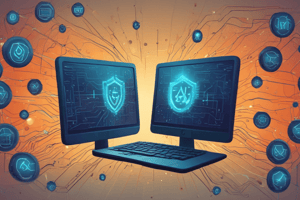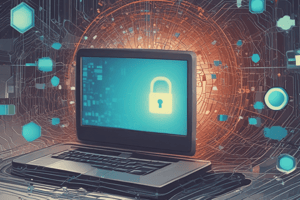Podcast
Questions and Answers
Which devices require anti-virus protection?
Which devices require anti-virus protection?
- Workstations
- Servers
- Mobile computing devices
- All of the above (correct)
Who is responsible for scanning suspicious emails and files?
Who is responsible for scanning suspicious emails and files?
- IT support
- Users (correct)
- Third-party vendors
- Network administrators
What is the purpose of the anti-virus and malicious code policy?
What is the purpose of the anti-virus and malicious code policy?
- To protect networks and information processing facilities from malicious software (correct)
- To educate users about viruses
- To provide support for mobile computing devices
- To install and update anti-virus software
What should be done with suspicious emails and files?
What should be done with suspicious emails and files?
What is the consequence of violating the policy?
What is the consequence of violating the policy?
What is the role of third-party vendors in relation to anti-virus software?
What is the role of third-party vendors in relation to anti-virus software?
What type of scanning is needed to check web traffic for malicious software?
What type of scanning is needed to check web traffic for malicious software?
What standard is the policy in line with?
What standard is the policy in line with?
Study Notes
Anti-virus and Malicious Code Policy Summary
- The purpose of this policy is to protect networks and information processing facilities from malicious software.
- The policy includes all information processing facilities and mobile computing devices under the control of the company.
- Roles and responsibilities include installing and updating approved anti-virus software, monitoring and responding to alerts, and educating users.
- Users are responsible for scanning suspicious emails and files, reporting viruses, and not disabling anti-virus software.
- Third-party vendors must provide updates and support as needed.
- Anti-virus software must proactively and periodically scan for viruses, scan new code before production, and scan files received from external sources.
- Workstations, laptops, and servers all require anti-virus protection.
- Laptops may need alternative arrangements for virus definition updates when operated away from the trusted network.
- Gateway virus scanning is needed to scan web traffic for malicious software.
- E-mail content scanning should be used to check all incoming and outgoing emails for viruses.
- Violation of the policy may result in disciplinary action, unless a valid business case is provided and approved.
- The policy is in line with the Payment Card Industry Data Security Standard.
Studying That Suits You
Use AI to generate personalized quizzes and flashcards to suit your learning preferences.




